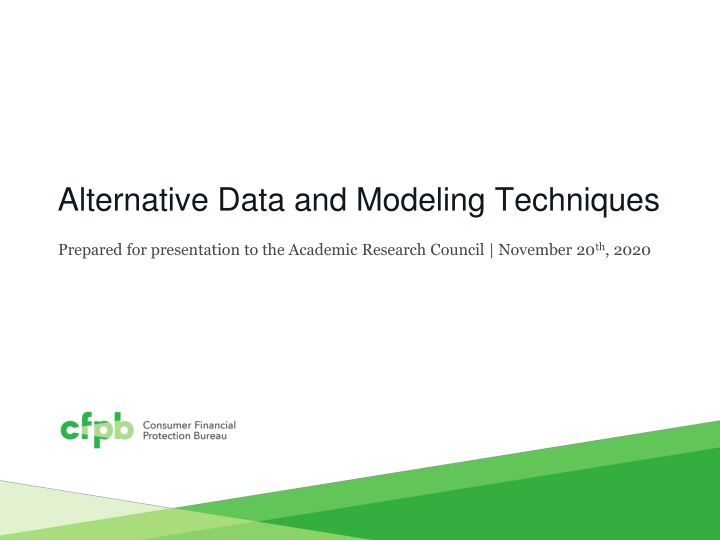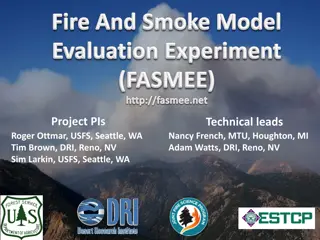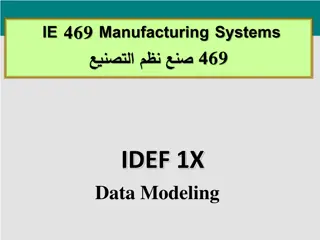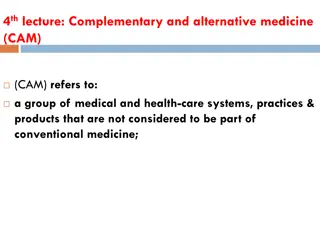Alternative Data and Modeling Techniques
This presentation delves into alternative data sources beyond traditional credit reports, highlighting their potential benefits in expanding credit access and providing a more precise assessment of credit risk. Examples of alternative data and its implications for consumers are discussed, shedding light on the evolving landscape of credit evaluation.
Download Presentation

Please find below an Image/Link to download the presentation.
The content on the website is provided AS IS for your information and personal use only. It may not be sold, licensed, or shared on other websites without obtaining consent from the author.If you encounter any issues during the download, it is possible that the publisher has removed the file from their server.
You are allowed to download the files provided on this website for personal or commercial use, subject to the condition that they are used lawfully. All files are the property of their respective owners.
The content on the website is provided AS IS for your information and personal use only. It may not be sold, licensed, or shared on other websites without obtaining consent from the author.
E N D
Presentation Transcript
Alternative Data and Modeling Techniques Prepared for presentation to the Academic Research Council | November 20th, 2020
Disclaimer This presentation is being made by Consumer Financial Protection Bureau representatives on behalf of the Bureau. It does not constitute legal interpretation, guidance, or advice of the Consumer Financial Protection Bureau. This document was used in support of a live discussion. As such, it does not necessarily express the entirety of that discussion nor the relative emphasis of topics therein. 2
What is Alt Data? Credit Bureau Report Identifying ( header ) info: Name, DOB, SSN, TIN, address history, DLN, phone #s Credit accounts ( trade lines ): Product types (mortgages, auto loan) Dates opened / closed Payment histories and balances owed Credit limits Payment status (e.g., current/30-60-90-DPD/ charged-off ) Third party collections Bankruptcy records Inquiries Alt Data = Everything else 3 Source: https://www.consumerfinance.gov/ask-cfpb/what-is-a-credit-report-en-309/.
Common Examples of Alt Data Payment data for non-loan products with regular payments: Telecom, utility (gas, water, electric), pay TV, home security services, streaming media Residential rent Cash-flow (bank) data Indicators of stability : changes in residences, employment, etc. Data about educational or occupational attainment Behavioral data 4
Potential Consumer Benefits 1. Expand credit access especially for unscorable consumers 5
Example: Potential Benefit of Alt Data 45 million consumers invisible or unscorable due to no-, thin-, or stale-credit files at largest credit reporting repositories. Consumers in low income areas more likely to establish credit history via negative records such as debt in collection. 6
Potential Consumer Benefits 1. Expand credit access especially for unscorable consumers 2. More precise reflection of true underlying credit risk in loan pricing 7
Potential Consumer Benefits 1. Expand credit access especially for unscorable consumers 2. More precise reflection of true underlying credit risk in loan pricing 3. Some consumers can feel as if they have greater control over data they agree to share 8
Potential Consumer Issues 1. Transparency for consumers a. Explainability and Adverse Action Notices 2. Privacy concern 3. Uncertain longer-term effects of consumer-permissioned data 4. Potential bias and/or discrimination 5. Data integrity risk with large volumes of data 7
What has the Bureau Done? Published study on the use of money transfer data to expand credit access (2014) Held building a bridge to credit visibility symposium (2018) Market monitoring (on-going) Held alternative data field hearing (2017) Devise & deliver online content to help consumers build credit responsibly (on-going) Granted alternative data related No Action Letter (2017) + provided update on results (2019) Interagency statement on use of Alt Data (2019) Procurement of Alt Data (on- going) Published alternative data request for info (RFI) (2017) 8
Procurement of Alt Data - In the process of procuring alt data and plan to match the data to credit bureau data - Historical panel data (2016-2020) and may exercise option years for several more years - Spoke with multiple vendors (e.g. Lexis Nexis, Experian, Equifax etc.) - Expect to receive data some time next year 2021 - 1.5~ 2 million consumers 11
Sample Strata 1. 25% of the sample (375,000~500,000 consumers) will include consumers who have scorable files ( thick ), defined as likely having a FICO credit score at some time between January and August 2016. 2. 25% of the sample will include consumers who likely have unscorable files ( thin ), but never a scorable file at some time between January and August 2016. 12
Sample Strata 3. 25% of the sample will include consumers who likely have no credit record at one of the three nationwide consumer reporting agencies at any time between January and August 2016, but have a credit bureau record at some time between September 2016 and December 2020. 80% of 25+ years old 20% of less than 25 years old 4. 25% of the sample will include consumers who likely have no credit record at one of the three nationwide consumer reporting agencies from January to August 2016, and no credit bureau record between September 2016 and December 2020. 80% of 25+ years old 20% of less than 25 years old 13
Questions When the Bureau is deciding which alternative datasets to acquire, what aspects would the ARC recommend considering? Are there specific datasets that the ARC would suggest considering? 14
Questions What type of privacy concerns with alternative data should the Bureau consider or research? 15
Questions Does the ARC have thoughts on how Industry s use of alternative data and alternative modeling approaches, such as machine learning, might affect the explainability of credit decisions in general, and the disclosure of adverse action reasons to consumers in particular? 16
Questions Does the ARC have guidance on research approaches to test for discrimination when institutions use alternative data? 17























